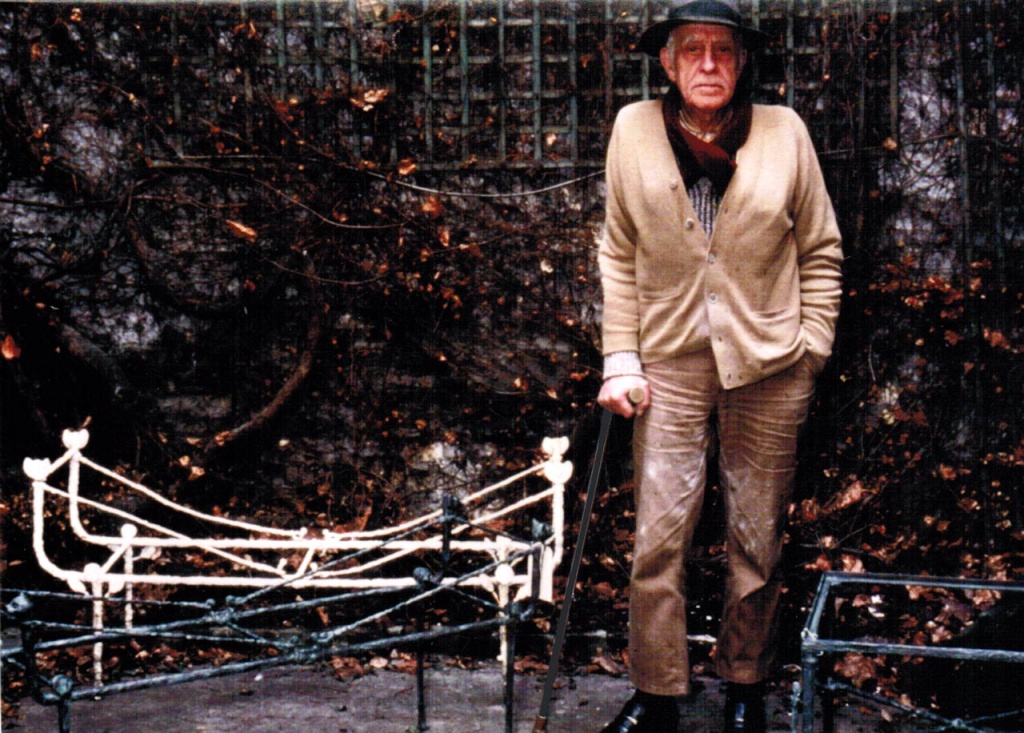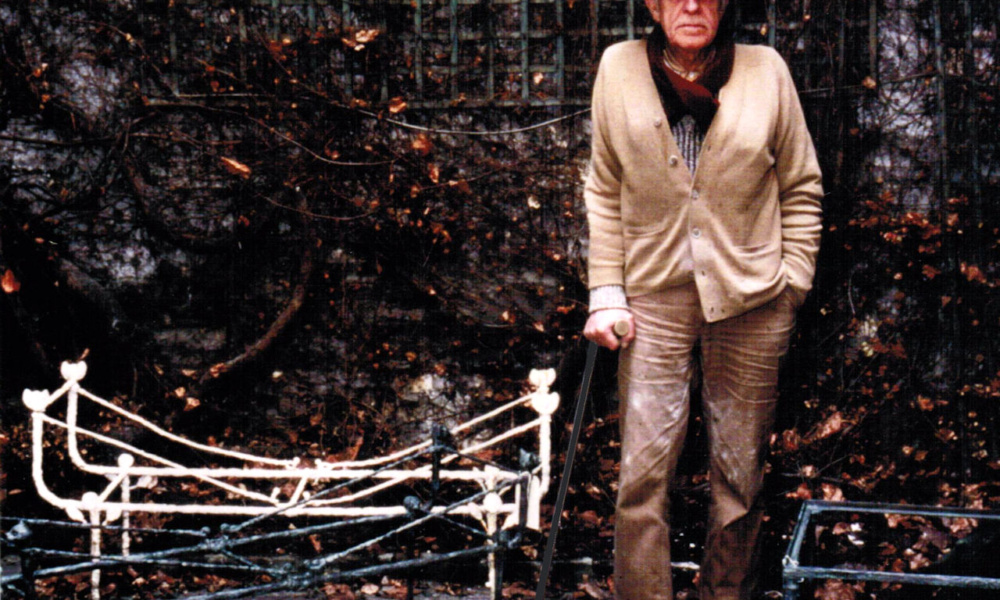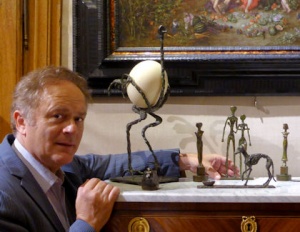
One year younger than Alberto, Diego Giacometti distinguished himself by producing bronze furniture animated by figurines. His work, while in the same movement as that of his brother, is completely independent. From the 1950s, using potter’s clay, plaster or bronze, he gave life to a bestiary marked by poetic naivety, the humour of which, in the poses adopted by the small animals, in no manner neglected the elegance of the forms. Overloaded with work, Diego Giacometti did not keep any written registers, orally managing the numerous orders placed with him without giving written quotes. In this article, Gilles Perrault presents the career of the Swiss sculptor, refers to the various difficulties encountered by experts when analyzing his works and describes the progress that has been made in such expert reports, due, in particular, to the compilation of a database and the activities of several experts acting in defense of the artist.
Article in the Revue Experts n°125 – April 2016 @ Revue Experts
In the 1920s, the brothers Alberto and Diego Giacometti left their native village of Stampa in the Swiss canton of Grisons and, one after the other, moved to Paris. Isolated in the teeming capital, the two brothers, reunited in 1927, maintained a bohemian way of life until the sculptures of Alberto were discovered by the avant-garde decorator Jean-Michel Frank in 1928. At the beginning of the 1930s, they received orders from Frank and the Ets. Chanaux company for lights (wall lights, free-standing lamps) and accessories (vases, andirons, banisters, door handles, etc). For the Parisian then international intelligentsia, they produced a sober and purist design.
Older by one year, Alberto dealt with public relations and discussed the orders. Diego, happy to escape such constraints, ensured the technical logistics within the indestructible tandem.
For nearly 40 years, in parallel to his own work as a sculptor and staunch collaborator, he made clay sculptures, their plaster moulds (hollow casts), then their plaster copies (original plaster from the hollow mould) to ensure their lasting nature, before making bronze copies in an art foundry. Due to his repeated and well-intentioned acts, Diego knew every morning the number of his brother’s works that the latter, a night owl haunted by a search for the perfect, had destroyed on returning home.
This repetitive work was not a constraint for Diego due to the absolute friendship and admiration he had for his brother.
After the Second World War, Diego’s talent in producing narrative bronze figurines in synthetised forms grew. Using clay, plaster then bronze, he amused himself by giving life to a bestiary marked by poetic naivety. Diego’s creativity, while in the same stylistic movement as that of his brother, is completely independent. The humour that emerges from the poses adopted by the small animals, rendered sympathetic under the fingers of the sculptor, in no way neglected the elegance of the forms.
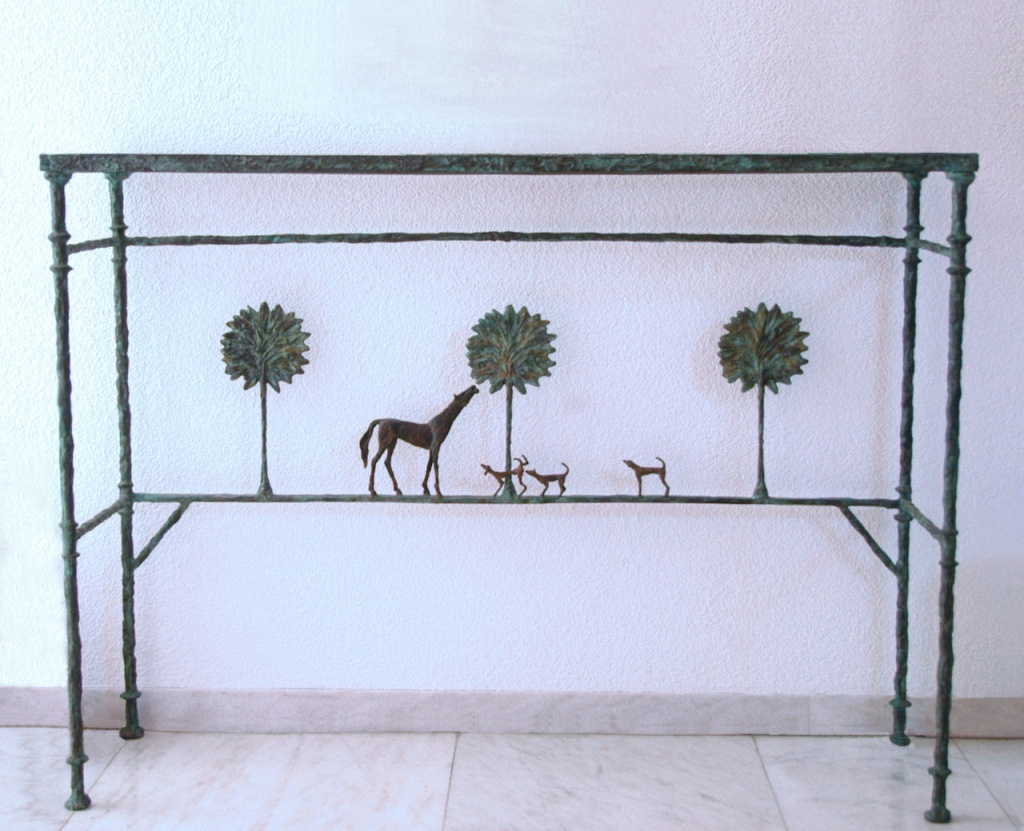
The Friends promenade – a line of three dogs of uncertain pedigree that live their lives without concerning themselves with what man thinks – is a quintessential example of this type of furniture.
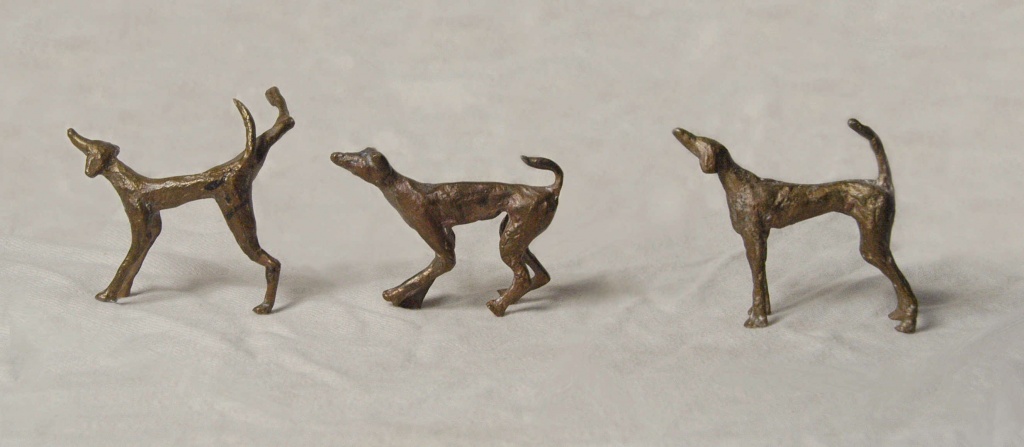
The animals distract one’s attention from the primary function of the object. Tables and consoles were part of his secret garden containing his fantasy bestiary. The cross-struts and feet are transformed into branches that support both a sparrow that has been drinking and a chimera ready to fly.
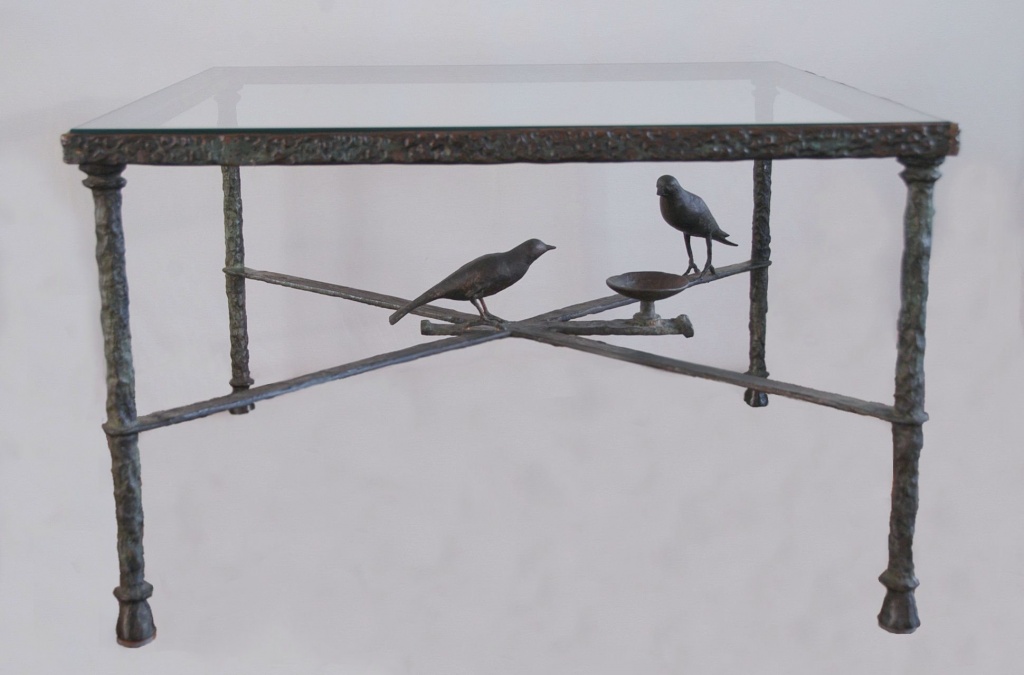
In contrast to this gentle wild life can also be seen a rearing horse and chevalier defending a belle held in a tower by a dragon.
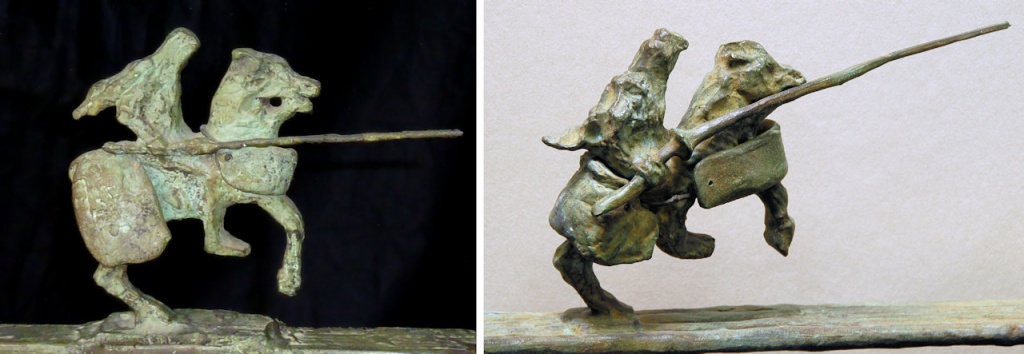
In 1954, the well-known gallery owner Aimé Maeght ordered items of furniture from him for his Parisian apartment then for the family home in Provence. In 1962, he created an open-air bar and furniture for the Maeght Foundation in Saint-Paul de Vence.
By around 1977, this ‘artisan’, as he liked to modestly describe himself, had transformed into a genius through the creation of his Ostrich. Professor Jean-Paul Binet, a friend of Diego’s, was the instigator. At Easter time, as a form of competition, he offered Diego and the artists Miro and Chagall an ostrich egg each as the basis for a future work of art.
This order produced one of the most complete and emblematic sculptured works of the 20th century. By placing the egg at the interior of an open sculpture, Diego recreates the eternal existential question: which comes first, the egg or the bird? His competitors, despite their talents, simply decorated an egg.
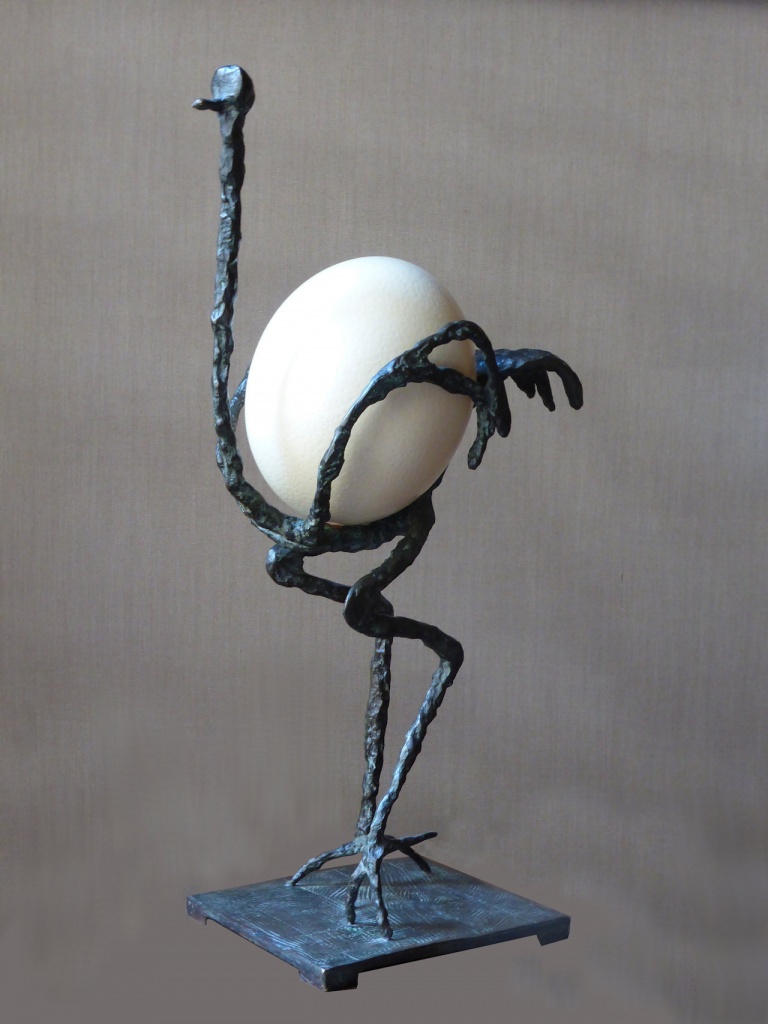
In Diego’s abundant bestiary is another major work, the Cat maître d’hôtel, created, from his imagination in reconciling the birds of Paris with his own cat, a cat standing upright with an enigmatic smile, offering food to birds on a platter then a wicker bowl. The artist mocks nature by transforming the predator into a gentle servant. He placed his first work in his courtyard and was immediately successful, with orders continuing until his death.
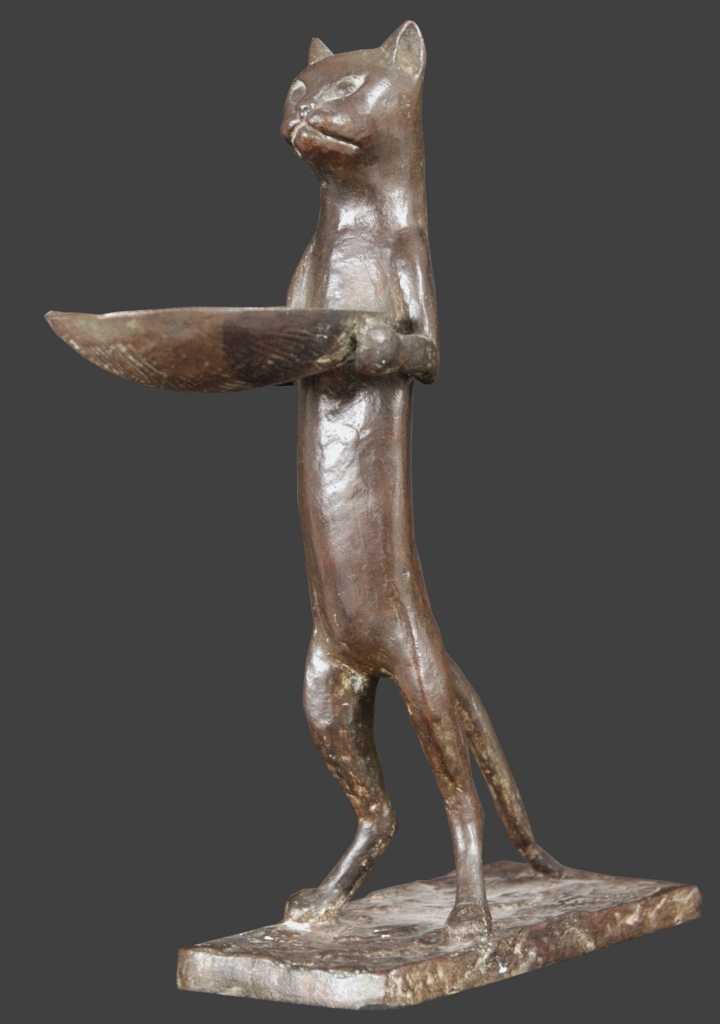
This good-natured humour characterised Diego himself, who was unaffected by his fame. He struggled to understand his increasing success with the bourgeois and dealers. Inundated with orders, he accepted them, dismissing any compliments. Resolutely humble, he liked to remain secluded in his workshop, bathed in his imagination.
Alberto died prematurely in January 1966. Profoundly affected, alone, Diego continued their workshop in Rue Hyppolite Maindron in Paris (14) and took refuge in his work. For the next twenty years, demand from his admirers only increased. Art lovers and gallery owners flocked to his workshop, leaving, for a wad of notes, the console that had just been finished for another client, who would wait for the next delivery and hope to at last be able to take it away. Penury inflamed popularity. Even though Diego did not benefit by increasing his prices, a true inflation occurred as he became more and more popular.
Under this constant pressure, Diego remained serene but struggled to satisfy his admirers, as many had built friendships with a man whose company was so agreeable.
An untidy single man, snowed under with work, he did not keep any registers. He had ostriches, cats, birds, fragments of tables, consoles and chairs cast in various foundries. Faced with this afflux of repetitive orders, the foundries anticipated the orders, moulding surplus items in sand, some of the master plaster models for which were signed. Diego supervised the assembly work and mainly dealt with adding animals or figurines by choosing where to place them. When possible, he applied the patinas, with help from Johnny (the son of a friend, whom he aided as if he was his own son).
Initially a client of foundries owned by families such as the Thinots in Paris then Châtillon or the Auberts in Paris, he also knocked on the door of the Susse brothers in Arcueil to satisfy the increasing demand for his work. Then, in 1984, at the pinnacle of his art, Diego received a substantial order from the Picasso Museum that he sent to the Redoutey foundry in Saint Sauveur in Franche-Comté.
Lucien Thinot, a former sand moulder at Eugène Rudier until 1947, was given a major part of the most complete, independent, works, the figurines and sculptures and also the furniture struts that would then go to the wrought-iron craftsman Franz Mons, assisted by Pierre Basse, to be assembled, screwed or welded, who also exclusively produced the seats of iron chairs and assembled them.
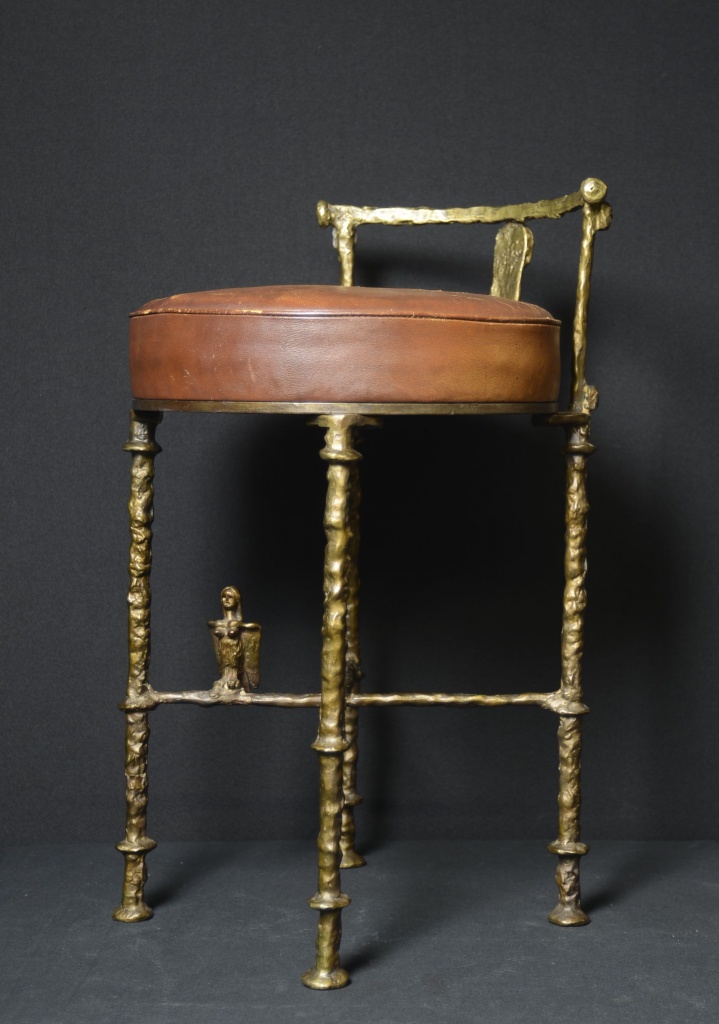
Despite his best intentions, the consecration much dreamed of by others arrived during his own lifetime. He received an order for a whole set of furniture from the Picasso Museum in Paris, which was inaugurated in September 1985, two months after his death.
Fifty items (benches, ceiling and wall lights…) were specifically created for the Hotel Salé. Renouncing his charming animal universe, too trivial if compared with the work of Picasso, he set his talent, his sense of volumes and spaces free.
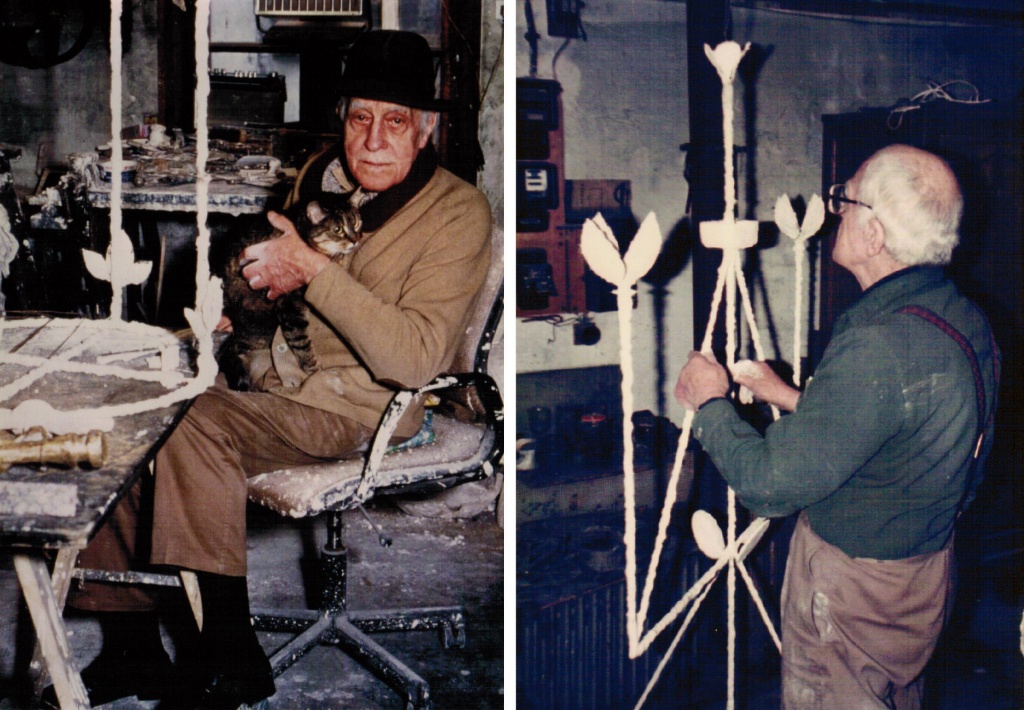
The fakes of Diego’s work
As a result of such chaotic management, essentially oral and without any preliminary quote, no expert would agree to assist in producing a catalogue raisonné (a full inventory) of his work after his death. Only Daniel Marchesseau (at the time the curator of the Museum of the Romantics), a friend of the artist, had the merit of producing a work in 1986 that remains a reference even today.
Already in the later years of his life, rumours had it that fakes were in circulation, the authors of which we still do not know, but such production can, with hindsight, be relatively easily distinguished and remains extremely limited.
More important were the post mortem fakes of items of furniture such as tables, chairs, consoles and some sculptures such as the Cat maître d’hôtel and The Ostrich… (cf. Art. Gilles Perrault in Revue Experts n°71, 2006, p. 37 à 42).
The Redoutey foundry, which held the master models for the order from the Picasso Museum in the Hotel Salé, continued with some additional productions, then was encouraged by defrauders who found outlets for the stock in Paris then nationwide. Again, with the popularity of his work not weakening, the foundry also produced inexistent models and overmoulds for works such as Cat maître d’hôtel and The Ostrich. This substantial production was eventually discovered by his heirs and Inspector Vincenot of the Dijon regional police acting on orders from an investigating judge in the Lure Department in 1989.
It was only in 2002 that Mr Hubert Bonin, Deputy Prosecutor at the Court of Appeal in Besançon, became aware of the amount of stock that had been seized. This included authentic master models and other fakes (overmoulds), with a resulting illegal production that nonetheless corresponded in all points with authentic works and a production proving the unlawful copying because it was produced from master models that were themselves fakes.
In 2003, this imbroglio was the subject of an expert assessment by the author of these lines and his team.
The Diego fakes produced by the Redoutey foundry were identified and destroyed, while the authentic master models were returned to the heirs in Switzerland, the Museum of Decorative Arts in Paris having declined the offer despite it holding in its reserves some of the models that had been used by Diego, who had stored them in the foundries or his workshop at the time of his death. To these two stocks were added other models that had been found that had come from the Thinot foundry and the wrought-iron craftsman, Monse.
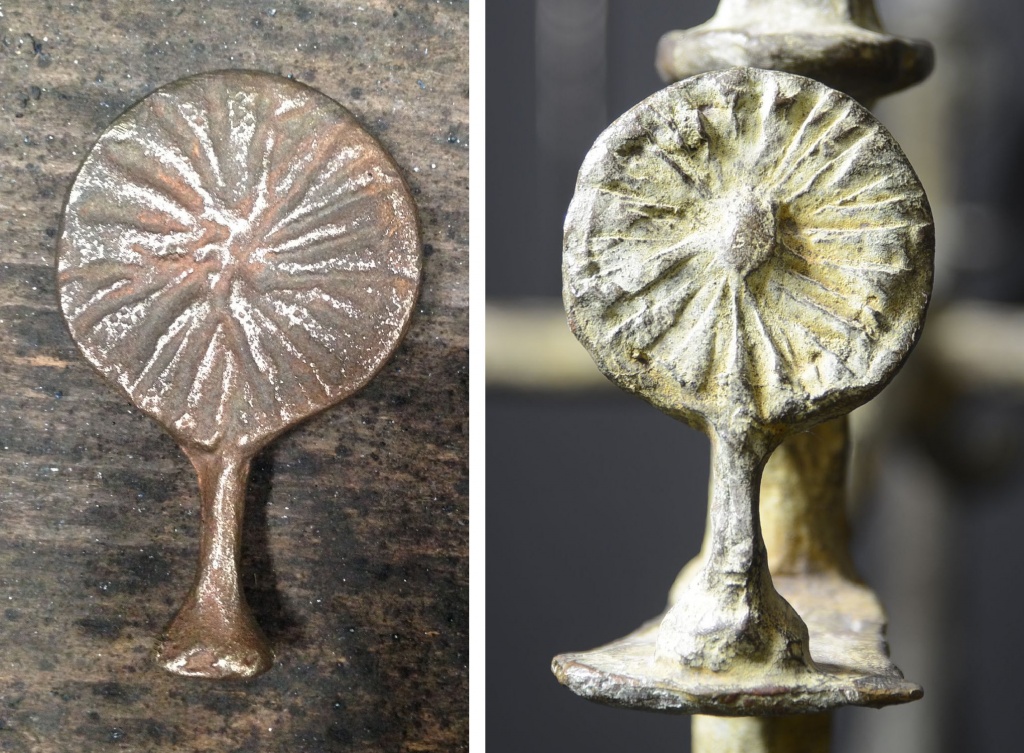
In 1991, despite a journalist deploring the sales of fake Diego works in London and New York from the Redoutey foundry and in light of the difficulty in listing all of the works from the foundry, no expert committee was formed. Very recently, a friend founder and expert exclaimed: “me, I won’t touch Diego’s work! Its too complicated!” Effectively, it is complicated and, therefore, risky. Despite this, how can we impotently observe all these fakes in circulation without doing anything about it?
Aware of the difficulty in carrying out an expert assessment of this very diversified body of work, we are expanding our database through expert assessments of more then 200 works that were produced during the artist’s lifetime, are reputed to be authentic and belong to private collections.
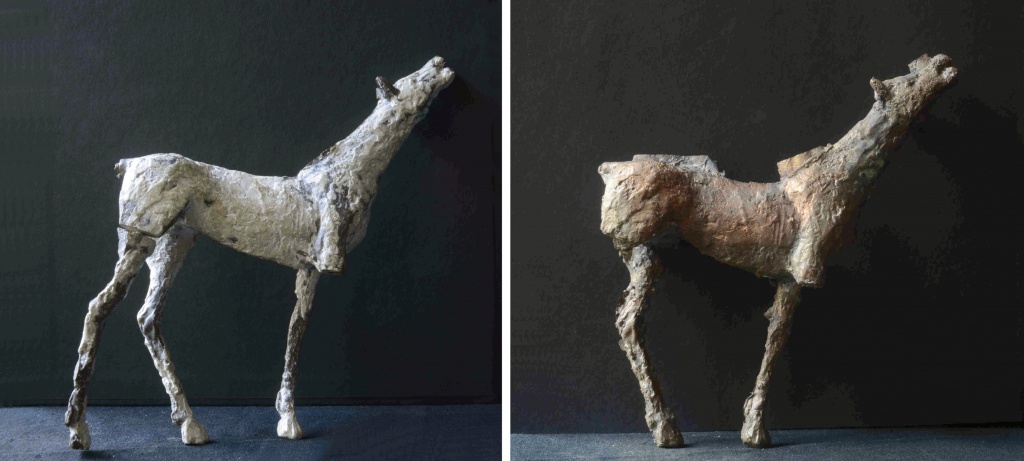
So, in light of these authentic works or master models, it is currently possible to carry out an expert assessment of the work of the artist, specifying its source even if the object is a fake.
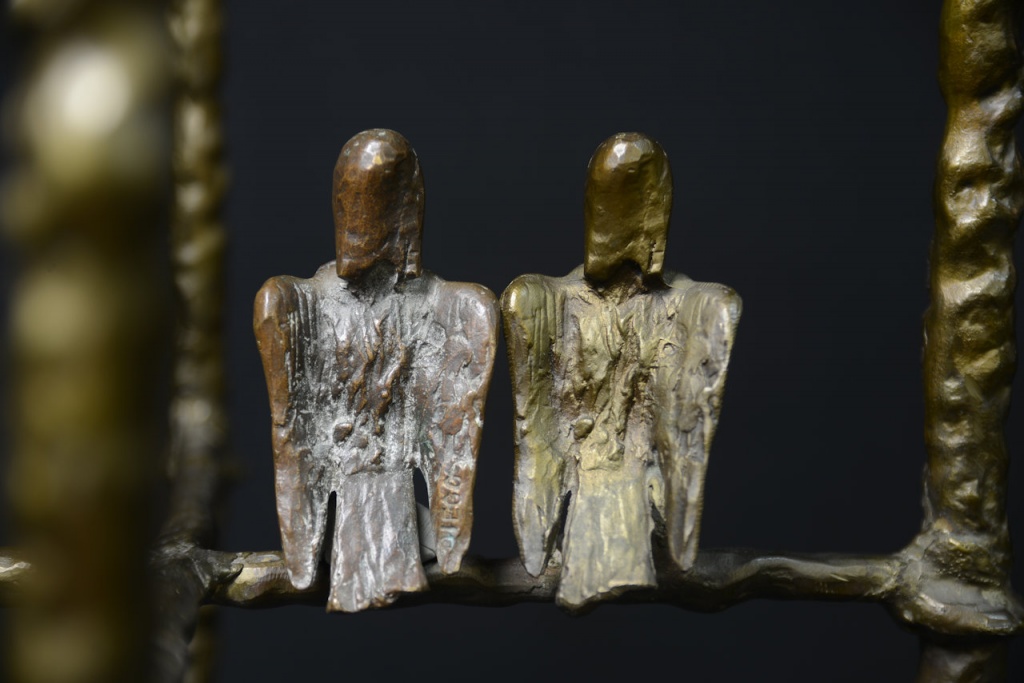
Alas, the increasing popularity of Diego has since generated other vocations for counterfeiters from the new world or Italy, where several talented founders, in financial difficulty, accept all sorts of orders. The trophy for such production must surely go to the Excalibur Foundry in Brooklyn, New York, a title that it does not hide from, moreover, having even a shop window on the Internet. It offers furniture such as tables, chairs and consoles, sculptures even the star lamp, which has now been attributed to Alberto by his beneficiary, the Alberto and Annette Giacometti Foundation in Paris.
For at least the past thirty years, the Excalibur Foundry, which had even set up a full stand of ‘authentic works’ at the Palm Beach ‘Annual Fair’ has never been in trouble with the A. and A. Giacometti Foundation or the beneficiaries of Diego. Its works are not authorised by the heirs of Diego and are, therefore, counterfeits within the meaning of Art. 71 of Schedule III to the French General Tax Code and Decree 81-255 of 3 March 1981.
We nonetheless repeatedly find works from such production appearing at auction houses with the claim of being authentic and accompanied by, of course, a reassuring source.
The popularity of the works of the two brothers is so substantial that a notorious case made the news in Germany in 2010. Approximately 1,000 fake Alberto Giacometti bronzes or plasters and 200 Diego furniture fakes were seized. Their owner, Lothar Senke (receiver), was sentenced by a Stuttgart court to five years and three months imprisonment. A German couple were defrauded of €6 million and a US auction house had even sold an Alberto copy for $27 million. Living in Thailand, the Dutch counterfeiter, Robert Driessen, out of pure vanity, admitted his involvement to the Der Spiegel journal in 2013, thinking he was beyond the reach of the law. Forgetting the extent of the Schengen agreements, he was arrested on the tarmac after a Bangkok/Amsterdam flight in 2014 and sentenced to five years imprisonment by a Munich court in June 2015. Fortunately, very few fakes are still in circulation and are easily identifiable. As for the works the subject of court-ordered expert reports, they are also part of our database.
The Diego experts
On reading these facts, it is easy to understand that very few experts dare defend such work. However, an American dandy, James Lord, living in Saint Germain des Prés in Paris, took on the role. After the death of Diego, whom he had frequented along with Diego’s brother, he issued handwritten certificates on the back of photographs of the works of Diego. Even obvious fakes were certified to be authentic. Even worse, from 2000 onwards, false ‘James Lord’ certificates were produced by an auction expert.
Genuine auction houses and dealers generally seek out other experts in order to guarantee the authenticity of the works by Diego. They contact Inspector Vincenot, who has since become an expert at the Court of Appeal in Dijon, and the wrought-iron craftsman Franz Monse, assisted by Pierre Basse (cf, article in the Gazette de l’Hôtel Drouot no. 24 of 19 June 2015).
The Swiss heirs, under the aegis of Mrs T.B. and her advisor, Maître Meier, continue to stop what appears to them to be unsupportable or criminal.
And the author of these lines, who is careful to maintain his independence by remaining at a distance to those operating in the market, but who remains very active in defending the artist.
Expert scientific and technical assessments
An expert assessment of the work of Diego Giacometti is essentially based on a comparison between authentic elements and those that are fakes. No numbering or statement of quantity has been listed, except in the books of some of the founders. The foundry stamps were affixed only on sculptures that were not items of furniture.
The dimensions, the nature of the alloy, the location of the welding and the systems of assembly of the chairs and items of furniture are observed in the tiniest detail, analysed and compared.
Each detail is important in the expert assessment and can constitute either positive or negative formal proof. Clearly, the expert’s task does not include revealing such information but it does include informing counterfeiters that their work, as skilful as it may be, is detectible and that they are subject to fines and imprisonment. An expert assessment serves not only to establish facts but also to prevent acts. Thirty years after the death of the sculptor, expert assessments of his work have at last become reliable due to database compilations and the observation of preciously kept master models to which experts have access. Requesting an expert assessment before purchasing a work therefore being a good investment…
